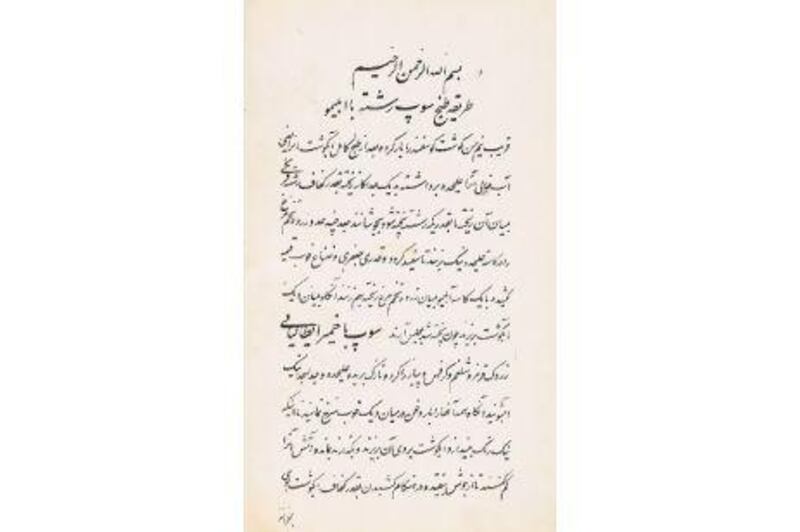When the Indian and Islamic Art sale opens in January at Bonhams, the auction house on London's New Bond Street, one of the lots on offer will be a 19th-century manuscript featuring recipes from Qajar Persia. The untitled 37-folio collection was commissioned by Muhammad Quli Khan-e Qajar Quyunlu Majd al-Sultaneh, who is thought to be the grandson of Fat'h Ali Shah Qajar.
The Qajars, a royal family of Turkish decent, ruled Iran from 1794-1925 and it is probable that this manuscript was written in the latter years of their reign. This book is particularly important, as few early Persian recipes remain in written form. As well as providing guidelines for how to make classic dishes, the collection also includes translations of French, Italian, Portuguese and British recipes. Among instructions for various soups, breads and sauces is a recipe for queen's potage soup, which is a thick broth made from boiled meats and vegetables and is likely to have been inspired by what was thought to be Queen Victoria's favourite soup.
The recipe that has aroused the most interest so far, though, is one for barbecued skewered peacock. Although nowadays we are more likely to see these colourful birds strutting around the gardens of stately homes, peacock was once regarded as a real delicacy. The recipe in question calls for the bird's skin and feathers to be carefully removed, with the neck left intact. It then suggests cleaning and seasoning the peacock before either wrapping it in grease-proof paper to be skewered and roasted or stuffed with vegetables and fried. While that doesn't sound particularly laborious, it is the presentation of this dish that demands precision and skill. The bird must be re-adorned with its feathers and skin, with the neck and head cleverly positioned to look as if it is about to take flight. The recipe does acknowledge that this process is a time-consuming one, often resulting in the meat being served cold.
In Tudor England, peacock was also regarded as a particular speciality. Boar head stuffed with rosemary and bay leaf may have been the original banquet centrepiece, but under Henry VIII, stuffed fowl become the popular option. Those legendary 14-course feasts featured all manner of meats, which many of us would baulk at eating today: beef lungs, larks, whale meat, porpoise and swan served in a liver sauce to name just a few. Among that lot, a gilded peacock perhaps doesn't seem so obscure - although much like the Persian version, this, too, was presented with pomp and ceremony. The stuffed bird was often placed in the middle of the table with a piece of bread (which was later set on fire) propping open its beak.
These rather splendid-looking birds are also known as peafowl, and although they're unlikely to appear on the menu at future dinner parties, the well-respected American magazine Gourmet features several peacock recipes in its archives. These were mostly published in the 1950s and 1960s and suggest cooking peacock in a similar way to turkey, basting the meat regularly to prevent the flesh from drying out. Gourmet provides recipes for roast young peacock, peacock with olive stuffing and an interesting-sounding peacock Louisiane - which involves braising the meat in grape leaves and herbs before serving it with croutons and orange segments.
Modern home cooking is, for the most part, a world away from such intricate preparations, with all their time and faff. These days, the quick fix rules and you only need look at the popularity of ready meals, shortcuts (ready grated cheese ring a bell?) and microwaveable or fast-cook solutions to realise this. Over the past few days, many of us will have sat down to enjoy a full turkey dinner. The thought of this is enough to put even the most experienced cook in a tiz - and with good reason, what with preparing the bird, slathering it in butter, ensuring that it's cooked through but not dry, not to mention providing all the trimmings. Still, if you compare this with plucking a peacock, stuffing, roasting and reassembling it to all its former glory, the turkey option does sound preferable.
* Emily Shardlow






